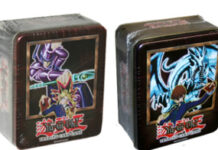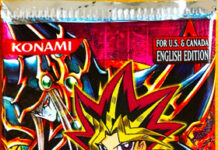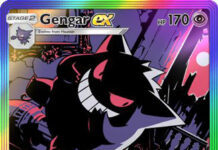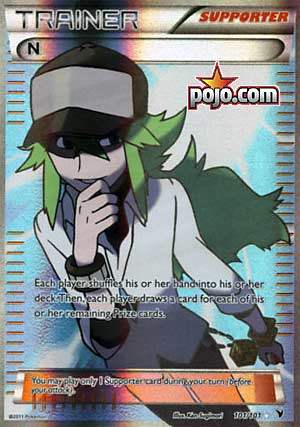 About a year ago, I did an analysis on the card N (Fates Collide, 105/124). While watching a game between two very good players on Youtube, the narrating player quickly identified that he had started the match with a completely dead hand. His counterpart had an excellent set up, and the narrator commented that he hoped his opponent would N him because otherwise he would surely lose in the next turn or two at most. As if on cue, his opponent promptly played N, replaced the awful cards in his opponent’s hand with the six most perfect cards he could possibly ask for, and the narrator went on to a fairly easy victory.
About a year ago, I did an analysis on the card N (Fates Collide, 105/124). While watching a game between two very good players on Youtube, the narrating player quickly identified that he had started the match with a completely dead hand. His counterpart had an excellent set up, and the narrator commented that he hoped his opponent would N him because otherwise he would surely lose in the next turn or two at most. As if on cue, his opponent promptly played N, replaced the awful cards in his opponent’s hand with the six most perfect cards he could possibly ask for, and the narrator went on to a fairly easy victory.
He would have lost. No question, no doubt whatsoever. It all changed when his opponent played N. Had the opponent not played N, he would have made quick work of the narrator.
We all have had this experience. We get a Greninja (Breakpoint, 40/122) hand on turn 1 and can’t get to the Concede button fast enough. Then our opponent N’s us and puts us right back in the game. It happens to me multiple times every night.
And don’t get me wrong – it happens the other way too where your opponent rips the cards you desperately need out of your hand, leaving you frequently with less cards that don’t do a thing to help you out. Plenty of players have stolen victories by using a late game N.
But how often does it really happen? How many times do you use N to paralyze your opponent at the end of the game and give yourself a sliver of a chance at victory? And how many times do you play N and inadvertently bring your opponent’s dead hand back to life? The Theorymon is obvious: if N helps your opponent significantly more than it hurts him, you shouldn’t play it. You should find some alternate source of draw support. That’s not just my opinion, it’s common sense. Why would you play a card that helps your opponent more than it hurts him?
So let’s get down to the nuts and bolts: let’s talk about the hard and fast numbers that don’t have any squishiness about them. Following are the basic, bare bones results of my testing.
- This analysis encompasses one hundred and sixty-six times that my opponent played N during the month of October 2017.
- The average number of cards in my hand at the time my opponent played N was 5.29.
- The average number of cards in my hand after my opponent played N was 5.40.
- Obviously, this means that my opponent gave me an average net increase in cards of 0.11.
- 77 of the 166 times (46%) my opponent gave me more cards than I had previously.
- 35 of the 166 times (21%) my opponent gave me the same number of cards that I had prior to the
- 54 of the 166 times (33%) my opponent gave me less cards than I had before he played N.
- Bottom line: almost half of the time, when you play N, you give your opponent more cards. Only one third of the time do you actually get to use N to reduce your opponent’s hand size.
- When my opponent increased my hand size, he increased it by an average of 2.08 cards.
- When my opponent decreased my hand size, he decreased it by an average of 2.61 cards.
- Bottom line: when my opponent was able to reduce my hand through N it worked effectively. My average hand size was 7.19 when my opponent played N to reduce the number of cards in my hand. My average hand size after reduction was 4.58.
- Remember, my opponent only reduced my hand size one out of every three times he played N.
- The average number of cards in my hand when my opponent played N to increase my hand size was 3.71. My opponent gave me an average of 2.08 cards every time he played N to increase my hand.
If you found the above text confusing, hopefully the charts below will bring it more into focus for you.
This is the frequency of the amount of cards in my hand when my opponent played N.
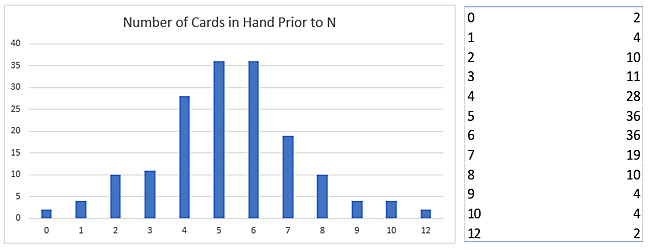
As you can see, four, five, and six cards were the quantities most frequently in my hand. Those three amounts total 100 (60%) of the 166 total times.
And the amounts after reshuffling:
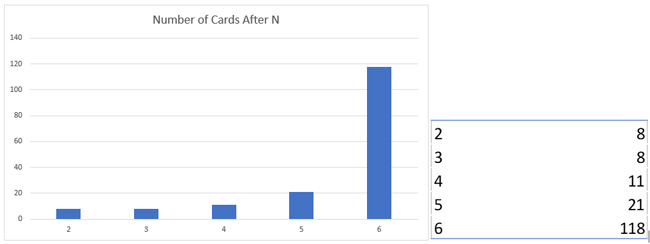
As you can see, the number of cards in hand after N gets played is almost always six. I’m sure the loss of VS Seeker (Roaring Skies, 110/108) has contributed to this significantly, and perhaps Lusamine (Crimson Invasion, 110/111) will help bring that number up. Of course, the major contributor to this lopsidedness will always remain the fact that many games end after a few prize cards are taken. Most games are not long drawn out battles.
But the fact is: my opponent only N’d me fourteen times when I had less than six prize cards. 152 times, he put six cards in my hand.
And below is the chart showing how often and by how may cards hand sizes are increased or decreased:
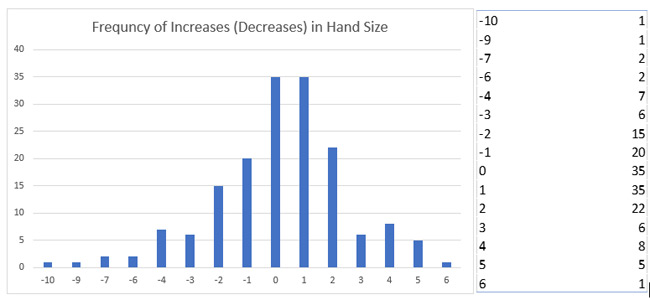
As you can see, when playing N, you are almost twice as likely to give your opponent an extra card as you are to take one away. And you are 50% more likely to give your opponent two additional cards as you are to reduce their hand size by two cards.
The data is clear: if you tech N into your deck, you have to know that the majority of the times that you play N, you’ll be giving your opponent more cards than he previously had prior to playing the N.
But does that automatically make your opponent’s hand better? If you give your opponent two more cards than he previously had, have you by default improved your opponent’s hand?
Here begins the squishiness that I hinted at a little earlier. This is the subjective part of the analysis. I can’t even begin to pretend that there isn’t an interpretation factor here. Again, we’ve all had it happen to us: you have the cards you absolutely need in your hand … and your opponent N’s you. It’s like a punch to your gut. That’s an easy call, it’s very simple to identify that one as hurting you. On the other hand, as I described at the opening of this writing, if your opponent N’s you out of a dead hand, it’s an easy check in the box that that N helped you.
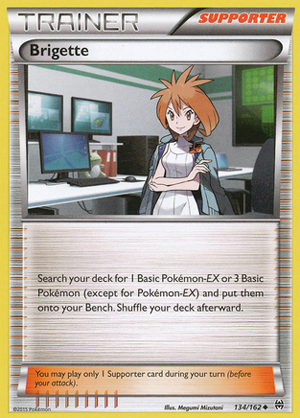 But what about the times that aren’t so clear? What if you have draw support and energy, and after the N you have energy and Pokemon but no draw support? What if you had a Brigette (Breakthrough, 134/162) and energy in your opening hand, and your opponent’s N takes away the Brigette but gives you back your own N and a Pokemon or two that you need but no energy? Many times there’s a fuzziness around whether a hand refresh actually helped or hurt you.
But what about the times that aren’t so clear? What if you have draw support and energy, and after the N you have energy and Pokemon but no draw support? What if you had a Brigette (Breakthrough, 134/162) and energy in your opening hand, and your opponent’s N takes away the Brigette but gives you back your own N and a Pokemon or two that you need but no energy? Many times there’s a fuzziness around whether a hand refresh actually helped or hurt you.
I didn’t follow any exact formula after my opponent N’d me to determine whether it helped me, hurt me, or neither. I just went by my gut feeling, and if it felt like I could continue on but the N minimally impeded me, I probably put neither helped nor hurt. I would say that the majority of the time, I felt comfortable identifying the result of the N in the helped or hurt categories. While not a tiny fraction of the time, I did have difficulty clearly determining the outcome of the N, and in those cases I chose neither helped nor hurt. It just was very clear to me that N was not binary, and I needed to reflect those occurrences in a bucket that wasn’t helped or hurt.
Below is the chart identifying how often N helped me, hurt me, or neither stratified by the amount of cards my opponent gave me or took away from me. I feel that this is the best way to analyze this, not by the amount of cards in hand before or after, but by the amount of the increase or decrease in number of cards.
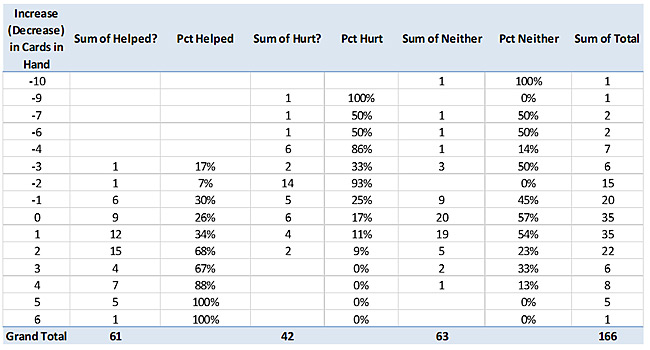
I think there’s a little bit of an abnormality with hand size being reduced by two, but other than that I don’t think there are any real surprises here. What we should take away from this:
- If you give me two or more cards, there’s a 76% chance you’re improving my hand.
- Three or more cards? 85%. You can do the math yourself for four or more cards.
- I think there might be a bit of an aberration with taking two cards away, but regardless, if you reduce my hand size by two or more cards, you hurt my hand at least 74% of the time.
- Anywhere from minus one card to an increase of six cards, there’s only a 13% chance that you’re actually hurting your opponent’s hand. If you give your opponent even a single additional card, there’s a less than 10% chance that you’ll hurt his hand.
- N never hurt me when I got an increase of three or more cards.
So from this data, I think we can clearly draw the conclusion that N has a place in the meta. If you can play N and reduce your opponent’s hand size by two or more cards, you will almost certainly disrupt his play and put yourself in a better position to win the game. I know I’m not telling you anything you didn’t already know, but this at least quantifies it.
What I believe most people don’t know, however, is how frequently you’re helping your opponent by playing N when they have a reduced hand size. Furthermore, I don’t think people actually realize the disparity between how often you play N to reduce your opponent’s hand size and how often you play it to increase their hand size. 46% of the time – nearly half of the times N was played – my opponent gave me more cards. Even giving me a single extra card was a 34% chance of improving my hand. Two cards was 68%. And only 33% of the times it was played did it reduce the number of cards in my hand. Put those two factors together, and, generally speaking, a player with N will lose games that they could have otherwise won had they not played N.
Because N has some value, this is not a clear-cut situation. We all know that there are plenty of reasons to play N. It has the advantage of not throwing away resources that will help you later in the game. It can put six fresh cards in your hand early in the match, and N can stymie your opponent’s developmental strategy if they run Alolan Vulpix (Guardians Rising, 21/145) or Talonflame (Steam Siege, 96/114). And if you’re running a deck that falls behind in prize cards, N is a mandatory four of almost without question.
I just believe that many people overvalue the benefits and fail to realize the significant downside of giving your opponent more cards than he currently has in hand.
The bottom line is that N helps your opponent more than it hurts him, and that’s why I recommend that you take a fresh, objective look at this card and really think about whether or not you want to play this in your deck.

